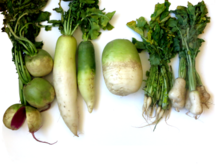
Back فجل أبيض Arabic মূলা Assamese Ağ turp Azerbaijani লম্বা সাদা মূলা Bengali/Bangla Rave blanc Catalan Ředkev setá bílá Czech Kinaradise Danish Winterrettich German Dajkono Esperanto Daikon Basque
This article needs additional citations for verification. (June 2024) |
| Daikon | |
|---|---|
 From left to right: watermelon radish, daikon, bái luóbo, waemu, yeolmu, and ponytail radish | |
| Genus | Raphanus |
| Species | Raphanus sativus |
| Subspecies | R. sativus subsp. longipinnatus |
| Cultivar group | White radish |
| Origin | North China[1] |
 Radishes in Okage Yoko-chō, Japan | |||||||||||||
| Chinese name | |||||||||||||
|---|---|---|---|---|---|---|---|---|---|---|---|---|---|
| Traditional Chinese | 白蘿蔔 | ||||||||||||
| Simplified Chinese | 白萝卜 | ||||||||||||
| Literal meaning | “white radish” | ||||||||||||
| |||||||||||||
| Alternative Chinese name | |||||||||||||
| Traditional Chinese | 菜頭 | ||||||||||||
| Simplified Chinese | 菜头 | ||||||||||||
| Literal meaning | “vegetable head” | ||||||||||||
| |||||||||||||
| Korean name | |||||||||||||
| Hangul | 왜무 | ||||||||||||
| Literal meaning | Wae radish | ||||||||||||
| |||||||||||||
| Japanese name | |||||||||||||
| Kanji | 大根 | ||||||||||||
| Kana | だいこん | ||||||||||||
| |||||||||||||
Daikon[2] or mooli,[3] Raphanus sativus var. longipinnatus, is a mild-flavored winter radish usually characterized by fast-growing leaves and a long, white, napiform root. Originally native to continental East Asia,[4] daikon is harvested and consumed throughout the region, as well as in South Asia, and is available internationally. In some locations, daikon is planted for its ability to break up compacted soils and recover nutrients and is not harvested.
- ^ Collins, Theophilos; Goodwin, Katie (1997). "Radish" (PDF). Hamilton College: Food for Thought: 1.
- ^ "daikon". Oxford Advanced Learner's Dictionary. Retrieved 2021-07-28.
- ^ "mooli". Oxford Advanced Learner's Dictionary. Retrieved 2021-07-28.
- ^ Larkcom, Joy; Douglass, Elizabeth (1994). Oriental Vegetables: The Complete Guide for the Gardening Cook. Oxford University Press US. pp. 114–115. ISBN 1-56836-017-7.